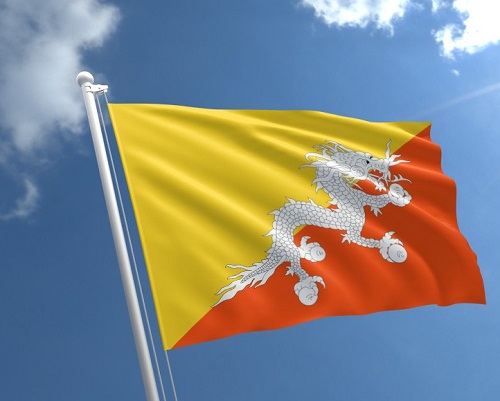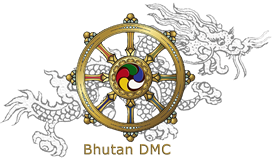National Symbols of Bhutan
National Emblem
The National Emblem of Bhutan is a circle, projecting a double diamond thunderbolt placed above the lotus. There is a jewel on all sides with two dragons on vertical side. The thunderbolt represents the harmony between secular and religious power while the lotus symbolizes purity. The jewel signifies the sovereign power while the dragons (male and female) stands for the name of the country Druk Yul or the Land of the Dragon.
National Flag
The National Flag is rectangular in shape that is divided into two parts  diagonally. The upper yellow half signifies the secular power and authority of the King while the lower saffron orange symbolises the practice of religion and power of Buddhism, manifested in the traditions of Drukgpa Kagyupa. The dragon signifies the name and purity of the country while the jewels in the claws stand for wealth and perfection of the country.
diagonally. The upper yellow half signifies the secular power and authority of the King while the lower saffron orange symbolises the practice of religion and power of Buddhism, manifested in the traditions of Drukgpa Kagyupa. The dragon signifies the name and purity of the country while the jewels in the claws stand for wealth and perfection of the country.
National Flower
The National Flower is Blue Poppy (Meconopsis Grandis), a delicate blue or purple tinged blossom with a white filament. It grows to a height of one meter, on the rocky mountain terrain found above the tree line of 3500-4500 meters.
National Tree
The national tree is Cypress (Cupressus torolusa), found in temperate climate zone between 1,800 and 3,500 meters. Its capacity to survive on rugged harsh terrain is compared to bravery and simplicity.
National Bird
The national bird is Raven and represents the deity Gonpo Jarodongchen (raven headed Mahakala), one of the chief guardian deities of Bhutan. The Raven, national bird also ornate the royal crown.
National Animal
The Takin (burdorcas taxicolor) is the national animal of Bhutan, looking like a cross between a cow and goat and associated with religious history and mythology of the country.
National Day
17th December is celebrated as the National Day that coincides with the crowing of Gongpa Ugyen Wangchuk as the first hereditary King of Bhutan, in Punakha Dzong on 17 December 1907.
National Anthem
The national anthem was first composed in 1953 and became official in 1966. It is known as Druk Tshenden Kepay Gyalkhab Na (In the land of the Dragon Kingdom, where cypress grows). It is religious in essence with lyrics consisting of prayers for peace and prosperity in the country, long life of the King and propagation of Buddhism.
National Language
The state language is Dzongkha which in the olden times was spoken by people who worked in the Dzongs that was seat of temporal and spiritual power. Later, Dzongkha was declared as national language of the country. Today, about 18 languages and dialects spoken all over the country.
National Sport
Archery was declared national sport in 1971 when Bhutan became a member of United Nations. Archery tournaments are among the most picturesque and colourful events in the country. Every village has its own archery range. High spirited competitions, usually accompanied by a banquet, are a part of all festive occasions.
National Dress
The national dress of Bhutan is called the 'Gho' for men and 'Kira' for women. It was introduced during the 17th century by Zhabdrung Ngawang Namgyal to give the Bhutanese a unique identity. The Gho is a long robe hoisted to the knee and held in place with a 'Kera,' a woven cloth belt, wound tightly around the waist. The Kira is a floor-length rectangular piece of cloth wrapped around the body over a blouse called wonju. The kira is held from the shoulders by broach-like hooks called 'Koma' and is fastened at the waist with a kera. The dress is complete with a short, open jacket-like garment called 'Toego.'
National Butterfly
Swallowtrail is the National Butterfly of Bhutan. Swallowtails are rare and are found only in Bhutan. They are usually found in Tobrang, a remote part of Bomdeling Wildlife Sanctuary, in Trashi Yangtse, in Far Eastern region of Bhutan.
HOTELS IN THIMPHU
HOTELS IN PUNAKHA & WANGDUE
HOTELS IN GANGTEY
HOTELS IN TRONGSA
HOTELS IN BUMTHANG
HOTELS IN MONGAR
HOTELS IN TRASHIGANG
HOTELS IN SAMDRUP JONGKHAR
HOTELS IN PHUENTSHOLING
HOTELS IN HAA
HOTELS IN GELEPHU
HOTELS IN ZHEMGANG
RESTAURANTS IN PARO
RESTAURANTS IN THIMPHU
RESTAURANTS IN PUNAKHA
TOUR ITINERARIES
TREKKING ITINERARIES
SPECIAL INTERESTS TOURS
UNIQUE FESTIVALS & FAIRS
BLOG


